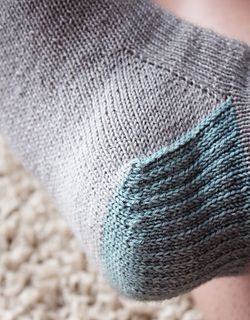patterns >  Lili Comme Tout Website and 1 more...
Lili Comme Tout Website and 1 more...
> Suzette






Suzette
This pattern is available in English and in French, you’ll get 2 different files when downloading.
Le fichier est disponible en français et en anglais, vous disposerez de 2 fichiers différents lors du téléchargement.
Are you finally ready to start knitting your first pair of homemade socks? Follow this step-by-step tutorial, full of explanations, photos and tips, especially made for beginners! The 2-colors version will keep you away from boredom and you can definitely change its look by adding a cable, a lace or textured stitch, it will always remain a good basis to express your creativity.
For this pattern/tutorial, I chose to use the magic loop technique to knit in the round, because I thought it would be the easier one to start with, but you can use DPNs if you’re more comfortable with them (just split your stitches over 4 needles instead of 2 in this pattern), or with 2 circular needles.
I also chose to knit this pattern from the toe up, which has the huge advantage to enable to try the sock on as you knit it, to check the fit and adapt if necessary, plus you can use all your skein (or at least be sure to have enough yarn for both of them!).
Every step is illustrated by a step-by-step photo tutorial, all the techniques are precisely described, you will have all the cards in your hand to take up the challenge!
Sizes:
• S-M-L
(For a foot circumference of 18-20-23 cm /at the
largest part - under the toes)
Length is adaptable to your size.
Gauge:
• 32 stitches and 44 rows = 10 cm/4’’
in stockinette stitch in the round
Stitches:
• Stockinette flat and in the round.
• 1:1 rib.
Yarn & Notions:
• 1 skein or 300 m / 320 yds of sock yarn, here shown
in Countess Ablaze Lady Katherine Sock (85% wool,
25% nylon) in the Grey Manchester Skies colorway for
main color and 40 m / 22 yds in contrasting color, here
shown in The Uncommon Thread - Uncommon Everyday
(100% merino) in the Duck Egg colorway (you can
also work with a unique color, 1 skein is enough).
• Circular needles to get gauge (suggested size: 2.5
mm/US#11/2).
• Tapestry needle.
Lancez-vous enfin dans vos première paire de chaussettes tricotées en suivant le pas à pas détaillé de ce modèle très simple parfait pour les débutantes, dans une version bicolore qui vous permettra d’égayer vos pieds avec élégance !
Vous pourrez facilement modifier le patron en choisissant un point texturé, en ajoutant une torsade ou un point de dentelle, il vous fera une excellente base.
J’ai choisi pour ce tutoriel la technique du magic loop pour tricoter en rond parce que je trouve que c’est le plus facile pour débuter, vous pouvez cependant choisir d’utiliser des aiguilles double pointe (il faudra du coup adapter le tutoriel pour passer le nombre de mailles sur 4 aiguilles) ou avec 2 circulaires.
Ce modèle se tricote de la pointe des doigts de pied vers la cheville (toe-up en anglais), qui a l’avantage de permettre d’essayer au fur et à mesure et d’utiliser tout son écheveau si on le souhaite (en tout cas d’être sûr d’avoir assez pour finir les 2 chaussettes !).
Chaque étape est précisément illustrée par un tutoriel photo, toutes les techniques sont précisées en détails, vous aurez toutes les cartes en main pour réussir ce joli défi !
Tailles :
• S-M-Ln tour de pied de 18-20-23 cm au point le plus large – sous les orteils)
La longueur est adaptable à votre pointure.
Echantillon :
• 32 mailles x 44 rangs
pour 10 x 10 cm de jersey en rond.
Fournitures & Matériel :
• 1 écheveau ou 300 m de laine à chaussette ici en Countess Ablaze Lady Katherine Sock (85% laine, 25% nylon) coloris Grey Manchester Skies pour la couleur principale et 40 m en coloris contrasté, ici The Uncommon Thread – Uncommon Everyday (100% merino) dans le coloris Duck Egg (vous pouvez aussi choisir de les faire en une seule couleur, un écheveau est suffisant pour
une paire).
• Aiguilles circulaires nécessaires pour obtenir
l’échantillon (taille suggérée : 2,5 mm).
• Aiguille à tapisser.
117 projects
stashed
128 times
2285 projects
stashed
1811 times
- First published: September 2015
- Page created: September 18, 2015
- Last updated: December 17, 2024 …
- visits in the last 24 hours
- visitors right now





